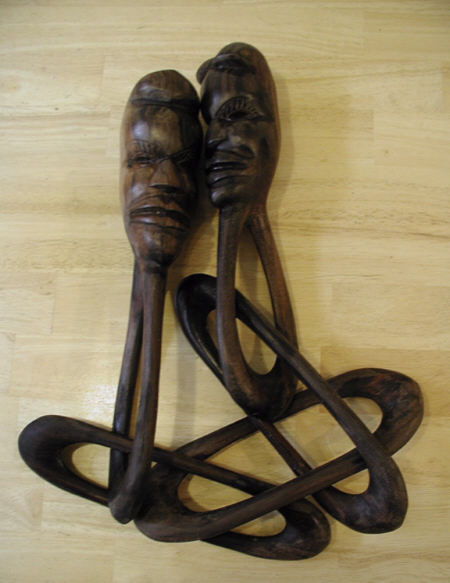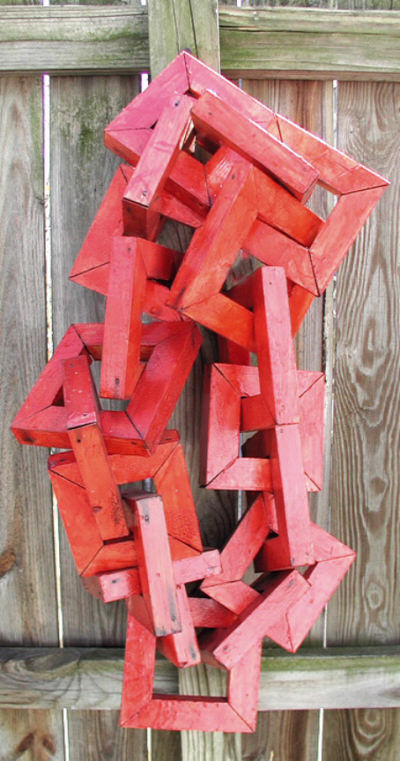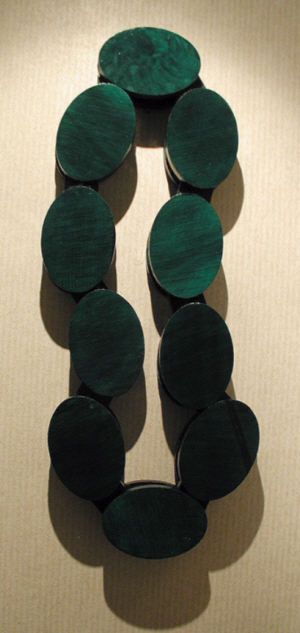Picked up a piece of airport art at a garage sale. I believe that the lady said it was from Kenya. It is a chain, carved from a single piece of wood with a stylized head at each end.

The chain has a nice heft. I hung it in my office and it contributed well to the décor. I used to stare at it while pretending to listen on the phone and it began to create patterns in my mind. Here was a physical rendering of a spiritual concept as many in Africa see life in terms of linkages.
I have a why center in my brain. I began asking why the chain as symbol was not more prevalent across cultures and why couldn’t I generate something along these lines.
Some possibilities came up. It occurred to me to create a version of the piece in my office. Make the chain long, steel, of stout links, and create heads representing some duality such as woman/man, black/white, etc. The black/white option appealed to me as I could imagine the long and rusty chain slung over some post in darkness above and the heads side-by-side and touching in a pool of light at eye level. They would be generalized images made of something heavy enough to put a tension on the chain – maybe cast iron. They would have a worn aspect as though from collisions with each other. The idea was reserved for another day.
That was one direction. It soon became evident that I had options galore as most anything can be linked up. Have you a stuffed bear and a roll of chicken wire? Link them. And chains come in all sizes and types and suit all manner of purposes. Where to begin?
One solution was a reach for simplicity in a workable medium. Shown here is an example of linked rectangles in wood, made by standard framing techniques.

This, at least, takes care of one possibility. I enjoy the gentle draping effect of these intertwined shapes.
At the same time I made a garish example meant to be blunt.

And recently I made this simple piece employing a bicycle chain concept.

Are they as nice as the Kenyan piece? No. But they do give me a place to stand as I figure what to do next.
But, for me, this remains terra incognita. I’ve scanned the net and found nothing that seems to touch on this subject in any significant way. Neither have I found book or article. But this may be willful ignorance on my part. If you know of somebody working in this general area or of a related source of information, then I’d like to hear from you.
Thanks
Jay

Jay, I thought the key aspect of the Kenyan chain was the combining of a sculptural element, the head, with the (potentially, at least) functional chain. This seems to be a darn powerful and political statement. You don’t seem to do this in your chains, even the bicycle chain one, which seems ideal for a picture or bas-relief. What do the chains mean to you, or what do you want them to mean to us? Do you have plans to incorporate sculptural elements?
Steve:
Do I detect two red chains? Or am I seeing double?
I agree that the Kenyan chain is a powerful statement. Question is, was it such to the artisan who made it, or did it represent just another day at the work bench? Regardless, it touches off sparks.
As I said, one spark that it kindled for me was the overall concept of linkage. I’m playing with a bunch of connective ideas right now that derive from that and which, frankly, are stretching my abilities to the limit. Every morning I wake up with five new ideas and the pile keeps getting bigger.
The suggestion about pictorial content is right on. I’ve considered decoupage and creating figured content within the broader context. I want to do it so bad. I can see faces, for example, within the green cartouche shapes in the one photo, and they’re all saying: “What are you waiting for?” But I’m holding back as I feel yet a stranger to these shapes and their ramifications. The images will come when the training wheels come off.
Sorry about the accidental image duplication, it’s now fixed.
I’m struck by your chain constructions with rectangular links; I don’t think I’ve seen anything like that before. They’re not just confining, the sharpness makes them look painful. The bike-chain style, in contrast, is very gentle and elegant.
Thanks.
I’m struck by them too. How can it be that something so elementary has been at large?
Sculpture as a medium is a headache. That very angularity in the gray chain means that, from a structural viewpoint, the chain is a bunch of weak links. It really should be made of metal. A certain someone who posts here has suggested that I leave it up on the fence to decay over the years and to photograph its gradual demise.
I’m thinking of making a bigger one and when I need to move it, I’ll hire the crew that schlepps the anaconda around at the zoo.
Steve:
Sorry..I get it now. Believe you me, I’d hate to get tangled up in that thing, what with its edges.
Jay,
Yesterday we went to a lecture at the Portland Art Museum by the (60’s, early 70’s) Art Forum critic, Rosalind Krauss.
While I certainly didn’t follow all that she said (she was reading from a manuscript with sentences so long I would lose the verb), some ideas kept coming through. I was reminded of them as I read your ruminations on your ideas of linkages, particularly the stuffed bear and the chicken wire.
Some of her important words were “self-reflexive” and “recursive” and “technical support” — the last not referring to being kept on hold for ten hours, but rather the “supports” on which art is mounted — stretched canvas as the old style — her new style examples were Ed Ruscha, William Kentridge who does hand-drawn cartoons set into a filmic mode (most powerfully, some on south african prisoners falling from the top of their prison), Documenta 10, where the entrance to the “exhibits” was part of the art, so foliage clumps from Africa were planted in the rail line that the vistors traveled over to get there, and others I don’t remember.
Anyway, you are playing with the support as the art in a technical sense and certainly some of what you say and show is recursive and self-reflective (particularly in some other pieces that I’ve seen of yours). What I like about your work, and Ruscha’s and one other that Krauss discussed,is that the art is interesting and intriguing in itself and admits of many ideas, and then, the language that you envelope it with gives it hues and tints and shades that make it even more intriguing. The language doesn’t overshadow the art (not yet, at any rate) but immerses it into a slightly different medium than it has when my eye gets immersed without the language.
I’m expressing all this badly, but it seems to me that there’s a working out of an inchoate impulse into an elegant and interesting verbal construction that takes your chains a ways down the road. And it definitely did resonate with the work you have shown.
Here’s Wikipedia on Rosalind Krauss: it’s a bit out of date.
http://en.wikipedia.org/wiki/Rosalind_Krauss
Jay,
I have seen many fine pieces of African art that MSU profs brought back from Zimbabwe in the 1980ties where they went to teach physiology. One of them, Jim Cunningham, even apprenticed himself to a Zimbabwe sculptor. Outside their departmental office, there is weird sculpture based on Leonardo da Vinci’s ‘Proportions of the Human Figure’ decorated with a strand of DNA (the departmental logo invented by the chairperson in his hubris) with a Shona head, done by Jim.
As you see, so far, I relate more to the heads than to the chains.
Birgit:
Do you mean the chains on the fence or the chain that connects the heads -or both? I ask this because what is being connected matters vitally in my estimation. I’m attracted to the nuts and bolts side of the linkage theme, but my ideas come more in images.
Wouldya, couldya get a picture of that weird sculpture? I’d love to see it.
June:
Back to the dictionary! Recursive like in wheat, heat, eat, at? I’m addicted to that kind of stuff. Inchoate I’m familiar with.
Gratified that a word smith like yourself appreciates my efforts to get a handle on this business. Actually the process of defining like this has a remarkably bracing effect.
Two thoughts have been vying for center brain today. I want to make a big knuckley object that hunkers there,like something that Tony Cragg might come up with. But I also want to do something where the connections are refined and poised more on thought than thing.
Jay,
I prefer the chain with objects other than just the links (Kenyan chain). With respect to your chains, like Steve, I also prefer oval links to sharp-edged ones.
In a couple of week, I can take a picture of the weird sculpture.
Jay,
Because Krauss’s lecture was close to impenetrable, I had to grab a couple of words to munch on later. I have always like “recursive” — all that twisting and turning back on itself — but I’m not sure if she said “self-reflective” or “self-reflexive.” Good either way, says I.
I did have to do some Googling acrobatics to find Kentridge’s name — his work grabbed both Jer and me — but neither of us could remember the name. His is the “technical support” that works beyond my imaginings.
Anyway, it’s always good to hear someone lecture in High Art Academese. It gives one a certain pleasure in writing simple sentences.
Jay,
I actually enjoy the chains without anything attached. The green ones are elegant and evocative of bike chains but also jewelry which has loads of meaning of course. What is the material for them? And the draping of the first one feels like a necklace too. Chain as shackle, chain as connector, chain as decoration…
I guess I don’t have a handle on where you are going, but I wouldn’t add a figurative element just because that solution works so beautifully in the Kenyan chain. It seems like you are going elsewhere. If the linkage is the important idea – what about really long chains that link things together that already exist, like two buildings, something more site specific? Now I am thinking of that couple who tied themselves together for a year but did not touch…Linda Montano and Tehching Hsieh
But the idea of a chain being a connector, both a voluntary and involuntary one is fascinating to me.
there is also a sculptor you may want to look at – Melvin Edwards – he did a series called “Lynch Fragments” – more than 150 welded sculptures from found metal objects including chains, hooks, hammers, spikes, handcuffs. http://www.africaresource.com/ijele/vol1.2/images1.2/irbham/index.htm
He picked up some of the fragments after the Watts riots of 1965. Obviously a very different social statement from the necklace idea! But the chain idea made me think of the violence of chains first, I must say. And chain gangs…
Leslie:
Thanks. Frankly I’m surprised at the responses. Steve mentioned the introduction of imagery, and I’m taking that seriously. But also folks have liked the chains as an elementary statement, and I’m taking that seriously.
I would have to say that we’re all wondering where this might go next. The chaining of two separate and significant objects is intriguing. I can see the curving shape of a line running from building to building. Takes me back to the seventies when I ran a rainbow effect from one side of a downtown arcade to the other. Ah, those were the days.
Spent a good part of today cutting out wooden ovals, so that would suggest something in the works.
All three objects in the post are of wood. I’m a liberal user of transparent varnishes and that contributes to the glow. The green one is sitting out back where I will add another layer of something to deepen the effect.
Off to see about this Edwards fellow.
Jay,
Images of a human face (in whatever distorted form they could come in) triggers a greater flood of chemicals in our brain than images of any mechanized non-living objects. In fact it is fairly well known that the brain has an area (the fusiform gyrus) dedicated to face processing expressly for this purpose. Decisions taken in this area are central to our everyday lives and input from this area to other relevant processing areas of the prefrontal cortex is paramount in maintaining a state of ‘correct’ cognition when we are in the midst of human beings – it is no wonder that the images of the Kenyan link face is powerful. I do like your first sculpture a lot – very necklacey..
Welcome to A&P
It reminds me of DNA, and how humankind is chained together with the illusion of individuality based on the ego.
Fantastic!
Angela:
As you may have gathered, I like garage sales. The other week I saw a molecule-making set (think Tinker Toys for adults) being sold by a dental student. It was a reminder to me that a far horizon awaits – molecular architecture being so vital and handsomely complex in its depictions. DNA is a centerpiece, depending where in the hierarchy of existence you are. But there are other configurations, consolidating hundreds of thousands of atoms, that operate like little biological machines. They wrap upon themselves according to their own valences and outside influences to become functional. I doubt if I have enough time left to me to make such a monster, but your comment about DNA has me thinking about the zip function and especially about something called RNA transcription. Thanks.
I like that!,